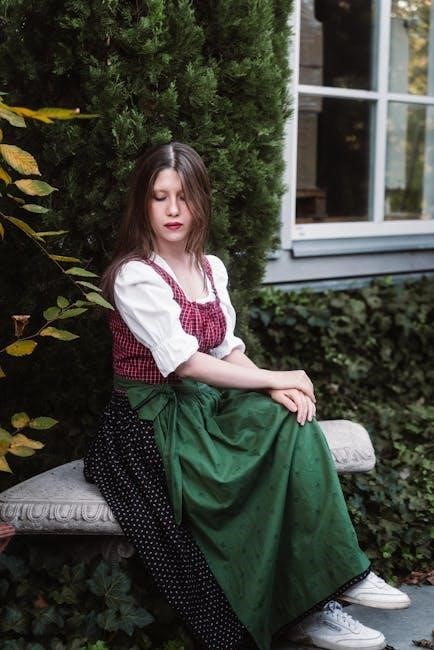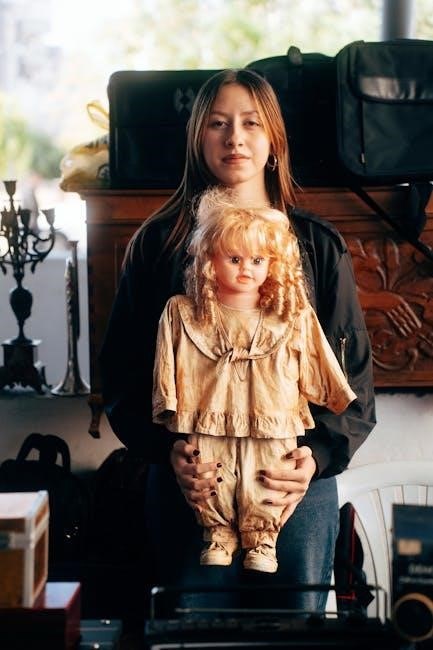Bertolt Brecht’s The Good Woman of Setzuan is a thought-provoking play exploring moral dilemmas in a corrupt society. Available as a free PDF‚ it details Shen Te’s struggles‚ blending parable with social critique‚ offering insights into human morality and survival.
1.1 Background and Publication History
The Good Woman of Setzuan was written by Bertolt Brecht during his exile in the United States. First published in 1943‚ the play critiques societal morality through the story of Shen Te. Its PDF versions are widely available‚ with translations by Eric Bentley. The play reflects Brecht’s Marxist views‚ blending parable with social critique. Academic platforms like Academia.edu and the Internet Archive offer free downloads‚ making it accessible for study and analysis. Its publication marked a significant milestone in Brecht’s oeuvre‚ influencing modern theater and literary discourse.
1.2 Overview of the Play’s Themes
The Good Woman of Setzuan explores themes of morality‚ survival‚ and societal corruption. It delves into the struggle between individual goodness and the harsh realities of life‚ questioning whether true virtue can exist in an unjust world. The play also examines the role of women‚ highlighting their challenges in a patriarchal society. Through its parable-like narrative‚ Brecht critiques capitalism and societal structures‚ offering a profound commentary on human ethics and the complexities of maintaining morality in a flawed system.

Plot Summary of “The Good Woman of Setzuan”
The play follows Shen Te‚ a kind-hearted prostitute in pre-Communist China‚ as she navigates moral dilemmas and societal pressures. Three gods test humanity by rewarding her kindness‚ but her generosity is exploited‚ forcing her to confront the harsh realities of survival and corruption.
2.1 Setting in Pre-Communist China
The play is set in the impoverished village of Setzuan‚ nestled in pre-Communist China. This backdrop highlights the stark social and economic disparities of the time‚ with widespread poverty and exploitation. The village serves as a microcosm of societal corruption‚ where moral values are constantly tested. Brecht uses this setting to critique the failures of capitalism and explore themes of survival versus morality. The pre-Communist era provides a rich context for examining the struggles of the working class and the ethical dilemmas faced by individuals like Shen Te.
2.2 The Story of Shen Te and Her Struggles
Shen Te‚ a kind-hearted prostitute‚ embodies the central conflict of the play. Her life is marked by a constant struggle between her innate goodness and the harsh realities of survival. After taking in three gods disguised as travelers‚ she is rewarded with wealth‚ but this newfound status only intensifies her moral dilemmas. Shen Te’s dual identity as both a compassionate individual and a pragmatic businesswoman highlights the tension between virtue and self-preservation. Her story serves as a powerful critique of societal expectations and the challenges faced by women in a corrupt world.
2.3 The Role of the Three Gods
The three gods in The Good Woman of Setzuan serve as moral authorities‚ seeking a genuinely good person in a corrupt world. They reward Shen Te for her kindness but remain detached from human struggles. Their presence highlights the play’s central themes of morality and societal dysfunction‚ questioning whether goodness can survive in an unjust system. The gods’ expectations contrast with the harsh realities Shen Te faces‚ underscoring the tension between divine ideals and human practicality.
Main Characters in the Play
Shen Te‚ a kind-hearted prostitute‚ and Wong‚ a wise water seller‚ are central figures. The three gods symbolize moral authority‚ driving the play’s exploration of goodness and survival.
3.1 Shen Te: The Protagonist
Shen Te‚ a kind-hearted prostitute‚ embodies the central conflict of the play. Her innate goodness is tested by the harsh realities of her world‚ forcing her to adopt a dual identity. As a symbol of moral struggle‚ Shen Te represents the tension between altruism and self-preservation. Her story‚ detailed in the PDF version of the play‚ explores themes of survival‚ love‚ and societal expectations‚ making her one of Brecht’s most complex and enduring characters.
3.2 Wong: The Water Seller
Wong‚ the water seller‚ is a pivotal character whose practicality contrasts with Shen Te’s idealism. He serves as a narrator and moral guide‚ offering insights into the play’s themes. Wong’s interactions with Shen Te and the gods highlight his role as a bridge between the divine and human worlds. His cynical yet realistic perspective underscores the societal corruption‚ making him a crucial figure in the play’s exploration of morality and survival‚ as detailed in the PDF version of The Good Woman of Setzuan.
3.3 The Three Gods and Their Significance
The three gods in The Good Woman of Setzuan embody divine authority‚ seeking a morally upright individual in a corrupt world. Their encounter with Shen Te highlights their role as testers of humanity’s goodness. Despite their celestial status‚ they are flawed‚ reflecting the contradictions of moral judgment. Their presence drives the plot‚ rewarding Shen Te’s kindness but also complicating her life. The gods symbolize the ideal of morality‚ yet their detachment from human reality underscores the play’s critique of societal hypocrisy‚ as explored in the PDF version of the play.

Themes Explored in the Play
The play delves into the struggle between goodness and survival‚ morality in a corrupt society‚ and the role of women‚ highlighting societal pressures and moral dilemmas.
4.1 The Struggle Between Goodness and Survival
The play centers on Shen Te’s internal conflict between maintaining her moral integrity and surviving in a harsh‚ exploitative world. As a kind-hearted prostitute‚ she faces societal pressures that test her ability to remain virtuous. The three gods’ expectation of unwavering goodness exacerbates her struggle‚ forcing her to adopt a dual identity to cope. This duality symbolizes the impossibility of pure goodness thriving in a corrupt society‚ highlighting Brecht’s critique of moral idealism in the face of economic and social realities.
4.2 Morality in a Corrupt Society
The play critiques the societal expectation of moral purity in a corrupt world. Shen Te’s kindness is exploited by those around her‚ highlighting the impossibility of maintaining virtue in a society driven by greed and exploitation. The three gods’ demand for goodness ignores the harsh realities of poverty and injustice‚ underscoring the disconnect between moral ideals and practical survival. Brecht’s portrayal of Setzuan as a morally bankrupt society challenges the notion of inherent goodness‚ emphasizing the need for systemic change over individual virtue.
4.3 The Role of Women in Society
Shen Te’s character embodies the struggles of women in a patriarchal society‚ where exploitation and limited agency are prevalent. As a prostitute‚ she faces societal judgment‚ yet her kindness and resilience challenge these norms. Brecht highlights the dual expectations placed on women: to be both virtuous and practical. Shen Te’s dual identity as a businesswoman and a mother reflects the tension between societal roles and personal survival; The play critiques the lack of autonomy and resources available to women‚ emphasizing their marginalization in a corrupt world dominated by male power structures.

Symbolism in “The Good Woman of Setzuan”
The play uses symbolic elements like the three gods‚ Shen Te’s dual identity‚ and the setting of Setzuan to explore moral and societal themes.
5.1 The Use of Gods as Symbolic Figures
The three gods in The Good Woman of Setzuan symbolize divine authority and moral judgment‚ seeking a good person in a corrupt world. Their presence highlights the tension between ideal morality and harsh reality‚ as they test Shen Te’s virtue. The gods represent Brecht’s critique of societal structures‚ emphasizing the impossibility of pure goodness in a flawed system. Their symbolic role underscores the play’s exploration of morality‚ survival‚ and the human condition‚ making them central to the narrative’s thematic depth.
5.2 The Significance of Setzuan as a Setting
Setzuan‚ a small‚ impoverished village in pre-Communist China‚ serves as the backdrop for Brecht’s exploration of moral and social dilemmas. Its depiction of economic hardship and corruption underscores the challenges faced by Shen Te and others‚ highlighting the tension between individual virtue and systemic oppression. As a setting‚ Setzuan symbolizes a world where morality is tested by harsh realities‚ making it a microcosm of universal societal issues. The village’s environment shapes the characters’ choices‚ emphasizing the struggle between survival and ethical behavior. This setting allows Brecht to critique capitalist exploitation and the impossibility of pure goodness in a flawed system. Thus‚ Setzuan’s significance lies in its ability to mirror real-world struggles‚ making the play’s themes timeless and universally relevant.

Historical Context of the Play
The Good Woman of Setzuan was written by Bertolt Brecht during his U.S. exile‚ reflecting his Marxist critique of capitalism and societal inequality. Set in pre-Communist China‚ it explores themes of economic struggle and moral conflict‚ influenced by Brecht’s experiences with fascism and his exile‚ offering a timeless commentary on class and morality.
6;1 Bertolt Brecht’s Exile and Its Influence
Bertolt Brecht’s exile from Nazi Germany in 1933 profoundly shaped The Good Woman of Setzuan. Living in Scandinavia and later the U.S.‚ Brecht’s Marxist ideals and critique of capitalism influenced the play’s themes of economic struggle and moral conflict. The play‚ set in pre-Communist China‚ reflects Brecht’s observations of societal inequality and his belief in the need for radical change. His exile experience heightened his political consciousness‚ infusing the narrative with a sharp critique of exploitation and a call for social justice‚ as seen through Shen Te’s struggles and the symbolic role of the gods.
6.2 The Play’s Relevance to Pre-Communist China
The Good Woman of Setzuan is set in pre-Communist China‚ offering a critique of societal inequality and moral decay. The play reflects the economic struggles and corruption prevalent during that era‚ with Shen Te’s story symbolizing the clash between individual virtue and systemic oppression. Brecht’s portrayal of a poor‚ exploited society resonates with the realities of pre-Communist China‚ where class divisions and moral compromise were rampant. The play’s themes of survival and morality remain timeless‚ providing insight into the human condition under oppressive regimes.

Reception and Criticism of the Play
The Good Woman of Setzuan initially faced controversy due to its critique of morality and societal structures. Its parable-like narrative sparked debates‚ with some praising its depth and others questioning its ideological stance. The play’s exploration of human struggle resonated widely‚ solidifying its place in literary discourse. Its availability as a free PDF has furthered its accessibility and critical analysis.
7.1 Initial Reception and Controversies
The play sparked controversy upon its release‚ with critics divided over its moral ambiguity and societal critique. Written during Brecht’s exile‚ it challenged traditional notions of goodness‚ leading to debates about its ideological undertones. Some viewed it as a powerful commentary on human morality‚ while others criticized its perceived pessimism. The play’s parable-like structure and exploration of moral dilemmas contributed to its provocative reception‚ making it a subject of both acclaim and contention in literary circles.
7.2 Modern Interpretations and Relevance
Today‚ The Good Woman of Setzuan remains a vital work‚ resonating with contemporary themes of morality‚ gender roles‚ and societal oppression. Modern scholars highlight its relevance to feminist studies‚ exploring Shen Te’s dual identity and the challenges women face in patriarchal systems. The play’s critique of capitalism and corruption also aligns with current global issues‚ making it a timeless commentary on human struggle. Its availability as a free PDF has furthered its accessibility‚ ensuring Brecht’s insights continue to inspire new generations of readers and theater enthusiasts worldwide.

Availability of “The Good Woman of Setzuan” in PDF
The play is widely available as a free PDF download on platforms like Academia.edu‚ Internet Archive‚ and eng-literature.com‚ ensuring easy access for readers worldwide.
8.1 Sources for Free Download
The Good Woman of Setzuan is accessible as a free PDF from various platforms. Academia.edu offers a detailed summary and analysis‚ while eng-literature.com provides a direct download link. The Internet Archive also hosts multiple versions‚ including translations and academic studies. Additionally‚ platforms like Surendranath College and Southwest Texas State University offer downloadable PDFs for educational purposes. These sources ensure easy access to Brecht’s classic play‚ making it readily available for readers and scholars worldwide.
8.2 Academic and Literary Platforms Offering the PDF
Academic platforms like JSTOR and Google Scholar provide access to The Good Woman of Setzuan PDF for scholarly purposes. University repositories‚ such as the University of Minnesota Press‚ offer downloadable versions for research. Literary sites like eng-literature.com and Surendranath College also host free PDFs‚ catering to students and scholars. These platforms ensure that Brecht’s work remains accessible for academic analysis and literary appreciation‚ supporting deeper engagement with the play’s themes and historical context.

Analysis of the Play’s Structure
Brecht’s The Good Woman of Setzuan employs a parable-like structure‚ blending episodic scenes with moral dilemmas. Its non-linear narrative and use of verfremdungseffekt challenge audience passivity‚ fostering critical reflection.
9.1 Dramatic Techniques Used by Brecht
Bertolt Brecht employs the verfremdungseffekt (alienation effect) in The Good Woman of Setzuan‚ distancing audiences to provoke critical reflection. He uses episodic scenes‚ symbolic characters‚ and direct address to break the fourth wall‚ enhancing the play’s parabolic nature. The three gods serve as moral commentators‚ while Shen Te’s dual identity highlights the tension between altruism and self-preservation. Brecht’s techniques create a dialectical drama‚ challenging viewers to engage intellectually with the moral and societal dilemmas presented.
9.2 The Play’s Ending and Its Implications
The ending of The Good Woman of Setzuan leaves audiences with a sense of moral ambiguity. Shen Te’s dual identity as a prostitute and a businesswoman is revealed‚ exposing the impossibility of sustaining pure goodness in a corrupt world. The three gods‚ satisfied with their discovery of a “good” person‚ depart without resolving the societal issues‚ highlighting the futility of divine intervention. The play concludes by underscoring the tension between individual morality and systemic oppression‚ leaving viewers to ponder the feasibility of ethical living in an unjust society.

The Play’s Influence on Literature and Theater
The Good Woman of Setzuan has profoundly influenced modern theater‚ inspiring adaptations and fostering critical discourse on morality and societal structures through its parable-style narrative.
10.1 Impact on Modern Theater and Playwriting
Bertolt Brecht’s The Good Woman of Setzuan has significantly influenced modern theater‚ particularly through its innovative use of parable and epic theater techniques. The play’s exploration of morality‚ survival‚ and societal corruption has inspired playwrights to adopt similar narrative structures and thematic depth. Its availability as a free PDF has further amplified its reach‚ making it a cornerstone for studying Brechtian dramaturgy. The play’s ability to blend political critique with emotional resonance continues to shape contemporary theater‚ encouraging experimentation and socially conscious storytelling.
10.2 Adaptations and Interpretations Over Time
The Good Woman of Setzuan has undergone numerous adaptations‚ reflecting its timeless relevance. Stage productions worldwide have reimagined the play‚ blending traditional and modern elements. Film adaptations and academic interpretations further explore its themes‚ while PDF versions enable global access‚ fostering diverse analyses. Its influence is evident in literature and theater‚ as artists continue to draw inspiration from Brecht’s exploration of morality and societal critique‚ ensuring the play’s enduring legacy in contemporary culture.
The Good Woman of Setzuan remains a timeless critique of morality and societal corruption. Its exploration of human dilemmas‚ available as a PDF‚ continues to resonate universally.
11.1 Final Thoughts on the Play’s Significance
The Good Woman of Setzuan remains a profound exploration of morality‚ survival‚ and societal corruption. Its themes‚ resonating across cultures‚ highlight the struggle between individual virtue and systemic oppression. Brecht’s critique of capitalism and human ethics‚ set in pre-Communist China‚ offers timeless relevance. The play’s availability as a PDF ensures its accessibility for modern readers‚ inviting reflection on its universal dilemmas. Written during Brecht’s exile‚ it reflects his deep concern for humanity’s moral fabric‚ making it a vital work in literary and theatrical discourse.
11.2 The Enduring Relevance of “The Good Woman of Setzuan”
Bertolt Brecht’s The Good Woman of Setzuan continues to resonate due to its exploration of moral dilemmas and societal contradictions. The play’s themes of survival‚ exploitation‚ and the struggle to maintain virtue in a corrupt world remain universally relevant. Its parable-like structure‚ set in pre-Communist China‚ transcends time and culture‚ offering insights into human nature. The availability of the play as a PDF ensures its accessibility‚ allowing modern audiences to engage with its profound commentary on ethics and societal expectations‚ solidifying its place as a timeless literary and theatrical work.

References and Further Reading
Academic papers‚ theses‚ and online platforms offer free PDF downloads of The Good Woman of Setzuan. Sources include Academia.edu‚ Internet Archive‚ and eng-literature.com for accessible versions and analyses.
12.1 Academic Papers and Studies
Academic papers and studies on The Good Woman of Setzuan are widely available in PDF format. Adkison’s 1994 thesis from Southwest Texas State University provides a detailed analysis of the play’s themes and characters. Additionally‚ platforms like Academia.edu and eng-literature.com offer free downloads of scholarly articles‚ including John Fuegi’s exploration of Shen Te’s representation. These resources are invaluable for understanding Brecht’s critique of morality and societal structures in the play.
12.2 Online Resources and PDF Versions
The PDF version of The Good Woman of Setzuan is accessible through various online platforms. Websites like the Internet Archive and eng-literature.com offer free downloads of the play. Additionally‚ academic institutions such as Surendranath College provide full-text PDFs for educational purposes. These resources include detailed summaries‚ analyses‚ and study guides‚ making them invaluable for students and researchers exploring Brecht’s work.
